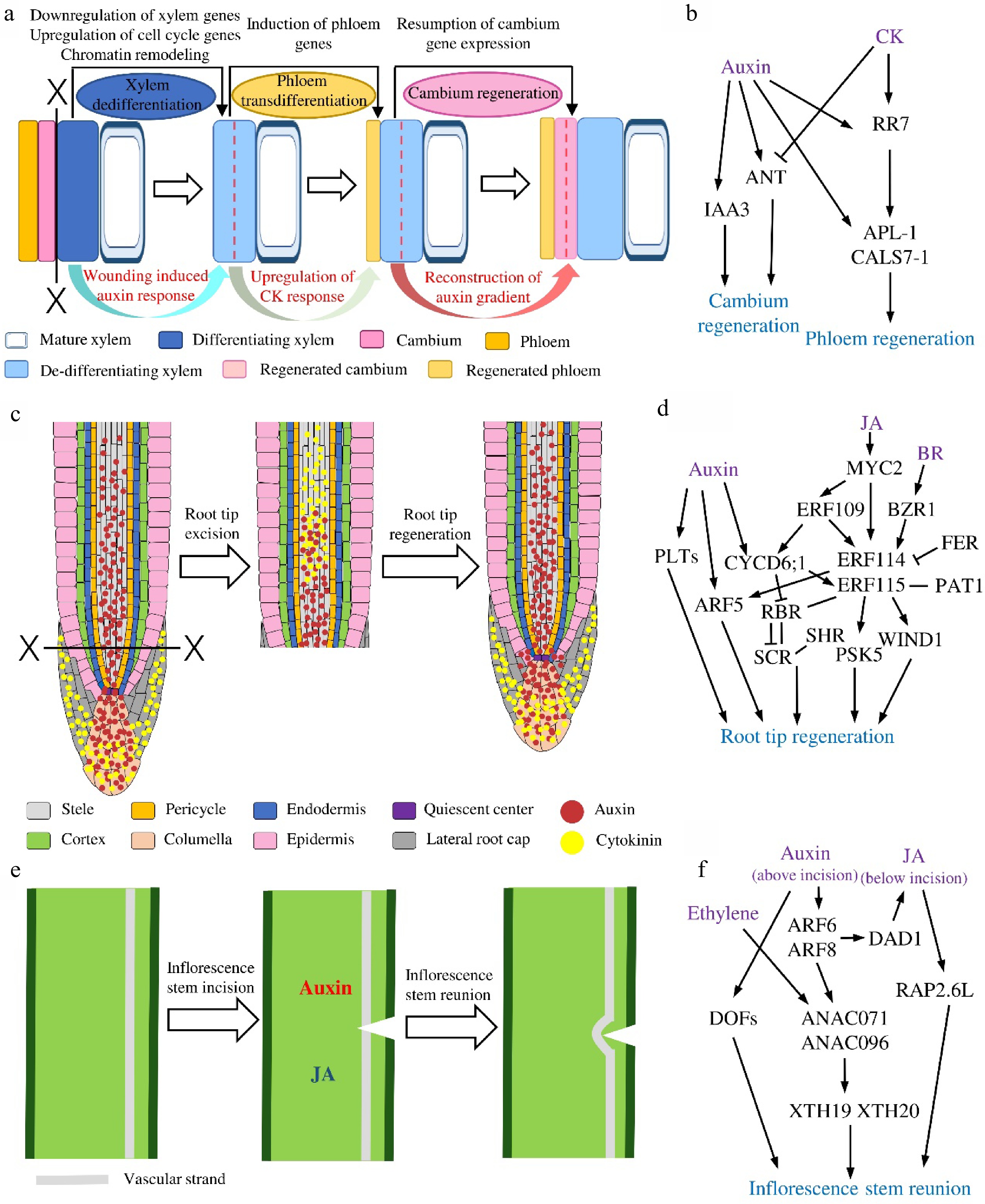-

Figure 1.
Diverse types of plant in situ tissue regeneration systems. (a) Shoot apex regeneration after excision. (b) Tissue reunion after incision. (c) Secondary vascular tissue (SVT) regeneration after bark girdling. (d) Root tip regeneration after excision.
-

Figure 2.
The regenerative dynamics and regulatory models of three plants in situ tissue regeneration systems. (a) Secondary vascular tissue (SVT) regeneration after bark girdling and (b) the proposed regulatory model in this system. Dotted lines indicate cell division. (c) Root tip regeneration after excision and (d) the regulatory model in this system. (e) Inflorescence stem reunion after incision and (f) the regulatory model in this system.
-
Regeneration systems Regulators Description Roles in plant in situ regeneration References SVT regeneration after girdling Auxin Phytohormone Inducing secondary vascular tissue (SVT) regeneration and required for cambium re-establishment [22,26,31,35] Cytokinin (CK) Phytohormone Promoting phloem regeneration, inhibiting vascular cambium restoration in in vitro system by blocking auxin maximum [22, 26] PtIAA3 AUX/IAA Auxin responsive and induced during SVT regeneration [26] PtRR7 Type-A response regulator CK responsive and induced during SVT regeneration [26] PtANT AP2/ERF Induced during cambium regeneration [22, 26] PtAPL G2-like Induced during phloem regeneration [22, 26] PtCALS7 Callose synthase Induced during phloem regeneration [22, 26] Root tip regeneration Auxin Phytohormone Accumulating at the wounding regions first and then moving distally, and required for the reconstruction of root apical meristem (RAM) [17] CK Phytohormone Overlapping with auxin first and then moving proximally, and required for the reconstruction of RAM [17] Jasmonic acid (JA) Phytohormone Stimulating stem cell niche regeneration in RAM [16] PLTs AP2/ERF Promoting root quiescent center (QC) re-establishment and root tip regeneration, and determining regenerative potential [71, 76] YUCs Auxin synthesis Required for root tip regeneration [72] ARF5 ARF Activated by auxin to promote the reconstruction of root tip [10, 42] ERF115 AP2/ERF Activated by JA, auxin and brassinosteroid (BR) to promote root regeneration after excision or cell ablation [16, 73−75] ERF114 AP2/ERF Acting redundantly with ERF115 to promote root tip regeneration [75] ERF109 AP2/ERF Activated by JA to promote the reconstruction of root tip [16] PAT1 GRAS Interacting with ERF115 to promote root tip regeneration [73] WIND1 AP2/ERF Regulated by ERF115 and required for root tip regeneration [73] PSK5 Phytosulfokine Regulated by ERF115 and required for root tip regeneration [74, 75] SCR GRAS Promoting QC and cortex cell re-establishment after cell ablation [47, 76] SHR GRAS Promoting QC and cortex cell re-establishment after cell ablation [47, 76] FEZ NAC Promoting lateral root cap (LRC) cell re-establishment after cell ablation [47] SMB NAC Promoting LRC cell re-establishment after cell ablation [47] Tissue reunion after incision Auxin Phytohormone Accumulated above the incision and enhancing JA production to promote inflorescence stem reunion but not cucumber or tomato hypocotyl reunion [20, 64] JA Phytohormone Produced below the incision to promote inflorescence stem reunion [20, 64] Ethylene Phytohormone Interacting with auxin and promoting inflorescence stem reunion [14, 64] Gibberellin (GA) Phytohormone Required for cucumber and tomato hypocotyl reunion but not inflorescence stem reunion [19] ARF6 ARF8 ARF Induced by auxin above the incision to promote pith cell division [80] PIN1 Auxin transporter Required for inflorescence stem reunion [20] ANAC071 NAC Induced by auxin and ethylene to promote cambial cell formation and tissue reconnection during inflorescence stem reunion [20, 48] ANAC096 NAC Promoting cambial cell formation and tissue reconnection during inflorescence stem reunion [48] RAP2.6L AP2/ERF Induced by JA but inhibited by auxin and promoting cell division and tissue reunion [64] XTH19, XTH20 Xyloglucan endotransglucosylase Regulating the proliferation and elongation of pith cell to promote inflorescence stem reunion [80] DOFs DOF Induced by auxin and cell wall damage, and required for inflorescence stem reunion [81] Table 1.
Roles of molecular regulators in plant in situ regeneration systems.
Figures
(2)
Tables
(1)